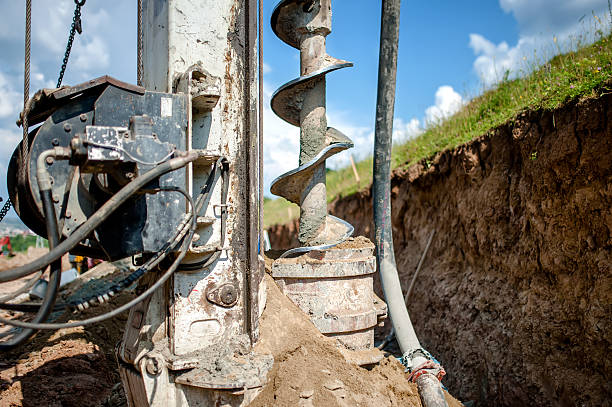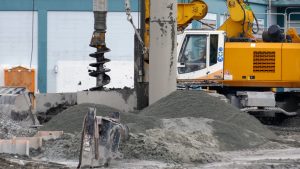Auger Drilling: An Essential Geotechnical Services Tool
- December 19, 2023
- Posted by: Velosi Author
- Categories: Geotechnical, Insights

Auger drilling is the pivotal method of discovering invaluable information beneath the surface level. But what is the significance of the auger drilling method?
As technology evolves, innovations in drilling methods continue to enhance our understanding of the Earth’s subsurface. However, the significance of Auger Drilling persists, standing as a testament to its enduring importance in geotechnical investigations.
This drilling method provides insight into soil composition, strength, and other important factors. Different environmental samples are used to discover contaminated areas under other industrial sites. This helps in preventing construction in challenging conditions and reduces the risks of chemical leakage during construction.
What is the Purpose of Auger Drilling – Types?
Auger drilling is a critical method used for exploring soil composition and strength by making boreholes under different areas. It includes a helical screw-like drill bit, known as an auger, attached to a rotating shaft which is made of a hard type of steel. As a result, it can easily pierce through different hard materials like soil and rocks.
How Does Auger Drilling Machine Work?
This machine works by rotating under the surface and creating boreholes. Moreover, it also brings back the soil to the upper surface for testing purposes. As a result, geologists can easily figure out numerous features of this soil through analysis.
| Types of Auger Drilling | Common Use |
| Continuous Flight Auger (CFA) | Deep boreholes in soft rock and cohesive soils for building foundations. |
| Hollow Stem Auger | Environmental sampling and installing groundwater wells. |
| Solid Stem Auger | Geotechnical investigations and shallow drilling in diverse soil types. |
| Bucket Auger | Excavating loose soils, post-hole digging, and sediment sampling. |
| Flight Auger | Small-scale construction, fence post installation, and soil sampling. |
| Vehicle-Mounted Auger Rig | Large-scale mining, exploration, and oil extraction in challenging terrains |

Benefits of Auger Drilling:
- A cost-effective method for easy soil sampling and perfect analysis in a short time limit.
- Auger drilling helps in differentiating different soil types, ground features like strength, compactness, and even standing ability.
- Crucial for resource exploration, infrastructure development, and scientific studies
- The soil from the deep surface can be used for multiple extractions. As a result, numerous analyses can be done through one drill down.
- It is an accurate method for construction, environmental monitoring, and research.
- The new and modern auger drilling machines don’t allow the soil to mix. As a result, keeping the soil safe and in the perfect shape for easy analysis using different techniques and experiments.
- It is a fast and efficient method for excavating soil and collecting samples.
- This method creates minimal disturbance to the surrounding environment compared to other drilling methods.
- Auger rigs are relatively compact and can access areas with limited space, making them suitable for urban and suburban projects.
Applications of Auger Drilling:
- Construction:
One of the most useful applications of this method is its importance in the construction industry. It perfectly identifies the soil features like composition and weight-bearing ability through the boreholes. As a result, it plays a crucial role in designing foundations for buildings, bridges, and other structures.
- Geotechnical Investigations:
It aids in geological surveys, soil sampling, and determining the feasibility of construction projects by analyzing subsurface conditions, identifying potential risks, and designing appropriate foundations.
- Environmental Studies:
Moreover, talking about another important factor of this drilling method includes a proper investigation of the soil segments. Numerous historical items have been discovered through this method of checking the soil and what’s underneath it.
- Agriculture and Mining:
This auger drilling process also plays an important role in the agriculture industry. It helps farmers in identifying the soil features and if it can support the crops for proper harvesting. Moreover, mining can be pretty impactful when you do know about the soil composition, as any foreign material can be easily identified.
Applications of Auger Drilling in Geotechnical Services:
This methodology serves various purposes in geotechnical investigations, including:
- Soil sampling: Collecting soil samples at various depths helps geologists and engineers analyze soil properties like composition, density, and strength.
- Standard penetration testing (SPT): This test measures the resistance of soil to penetration, providing valuable information about soil strength and bearing capacity.
- Cone penetration testing (CPT): This test involves pushing a cone-shaped probe into the soil to measure soil resistance and friction.
- Groundwater monitoring: Augers can be used to install monitoring wells to track groundwater levels and assess potential contamination.
- Environmental investigations: Auger drilling can be used to collect soil and groundwater samples for environmental testing and contaminant analysis.
Limitations of Auger Drilling:
- Limited depth: Auger drilling is typically limited to depths of about 100 feet.
- Not suitable for hard rock formations: Auger drilling is not effective in hard rock formations, requiring alternative drilling methods.
- Potential for soil contamination: Cross-contamination between soil layers can at times occur during auger drilling, requiring careful sampling techniques.
Conclusion
Auger drilling is a valuable tool for geotechnical services, offering an efficient and cost-effective way to investigate subsurface soil conditions. Its versatility and minimal environmental impact make it suitable for various applications, including shallow and deep investigations, soil sampling, and in-situ testing. By leveraging this indispensable tool, we continue to unearth crucial insights, laying the groundwork for safer, more sustainable, and resilient projects that shape the world around us. However, it is crucial to consider the limitations of auger drilling, such as depth limitations and potential soil contamination, when selecting the appropriate method for a specific project.
Please contact us for more information and assistance.



